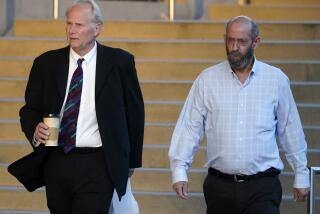Judge may rule on man’s innocence in arson deaths
- Share via
Reporting from Fresno — In a case that has highlighted the perils of forensic science, a federal magistrate is expected to rule soon on whether a man convicted of a triple murder arson may be innocent.
During a three-day hearing ordered by a federal appeals court, U.S. Magistrate Michael J. Seng heard evidence last week that suggested George Souliotes, 71, may have been wrongly convicted of setting a fire in a Modesto rental home he owned that killed three tenants: Michelle Jones, 31; and her children, Daniel Jones Jr., 8; and Amanda, 3. Jones’ husband was not at home during the fire.
Fire scientists have discredited evidence that was used to convict Souliotes, and the state has conceded that it no longer can prove the deadly blaze in 1997 was deliberately set. But prosecutors say the conviction should stand because other evidence pointed to Souliotes.
Even if he prevails, Souliotes will face other legal battles. His attorneys missed a legal deadline years ago, which ended his right to challenge his conviction. He must show innocence before federal courts will even consider his legal claims, which include a charge that his trial lawyers failed to defend him adequately.
Lawyers for the Northern California Innocence Project and Orrick, Herrington and Sutcliffe, who are representing Souliotes, presented a fire expert at the hearing who testified that he found no evidence that Modesto investigators ruled out potentially accidental causes.
Steven W. Carman, a fire investigator for 20 years with the U.S. Bureau of Alcohol, Tobacco and Firearms, said Modesto investigators relied on fire patterns and other forensic evidence that amounted to “a laundry list of things we used to believe broadly in this profession that have since been widely discounted.”
Carman testified that the blaze could have started as an electrical fire or from appliances such as the water heater, the washing machine or the dryer, which were located in the garage. Witnesses said the fire appeared most intense in the garage and living room.
“It seems to me from start to finish they were looking for arson,” said Carman, who reviewed the investigative reports and photographs for Souliotes.
But John DeHaan, another fire expert, testified for the prosecution that the fire appeared to have started in more than one place, a possible indication of arson.
DeHaan conceded under defense questioning that he received a preliminary ethics sanction from the California Assn. of Criminalists for giving scientifically unsupportable opinions in other unrelated arson cases. DeHaan said he appealed the finding, and the ethics case is still pending.
Souliotes, a Greek immigrant, was arrested several hours after the fire started. He was in the process of evicting the tenants and had put the house for sale. A witness told investigators that she had seen a recreational vehicle at the scene. Souliotes owned a Winnebago and a Cadillac.
Following Souliotes’ conviction and life sentence, his Winnebago sat in the parking lot of a Los Angeles restaurant owned by his sister and brother-in-law. The Glendale couple said they kept the truck because they thought it might one day be needed to prove his innocence.
On Jan. 1, the Winnebago was towed to Modesto. Souliotes’ legal team had someone videotape from a balcony where the witness had stood in the early morning hours of January 1997 as the Winnebago was driven up and down in front of what had been the fire scene.
The video, played during the hearing, suggested it would have been impossible for the witness to have seen the driver’s face as she stated.
Prosecutors objected that the lighting might have been different in 1997, but Seng took the video into evidence. To rule for Souliotes, Seng must find that no reasonable juror would have convicted him in light of the new evidence.
Seng has not indicated when he will rule.
More to Read
Sign up for Essential California
The most important California stories and recommendations in your inbox every morning.
You may occasionally receive promotional content from the Los Angeles Times.











